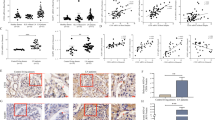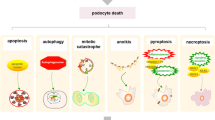Abstract
Background
Focal segmental glomerulosclerosis (FSGS) is characterized by podocyte damage and severe proteinuria. The exact mechanism of podocyte damage and loss remains unclear. Necroptosis, a lytic form of programmed cell death mediated by RIP3 and MLKL, has emerged as an important cell death pattern in multiple tissues and cell types. Necroptosis in FSGS has not been investigated.
Methods
Public GEO data regarding podocyte treated with vehicle or adriamycin (ADR) was identified and analyzed. Cultured human podocytes were used to explore the activation of necroptosis upon ADR stimulation. The expression of necroptosis pathway molecules, p-RIP3 and p-MLKL, was examined in the glomeruli and defoliated urinary podocytes of patients with FSGS. The effect of necroptosis inhibition was assessed in ADR-induced glomerulopathy mice using GSK872.
Results
Publicly available RNA-sequencing data analysis showed that both necroptosis and NLRP3 inflammasome pathway were up-regulated in ADR-injured podocyte. Immunofluorescent staining showed increased expression of p-RIP3 and p-MLKL, the active forms of RIP3 and MLKL, in podocytes of FSGS patients and ADR-induced glomerulopathy mice but not in the normal control. GSK872, an RIP3 kinase inhibitor, significantly inhibited the expression of p-RIP3, p-MLKL and activation of NLRP3 in cultured podocytes treated with ADR. GSK872 treatment of mice with ADR-induced nephropathy resulted in the reduced expression of p-RIP3, p-MLKL, NLRP3 and caspase-1 p20. GSK872 also significantly inhibited the expression of p-MLKL in the podocytes of ADR-induced nephropathy, resulting in the attenuation of proteinuria and renal histological lesions.
Conclusion
Necroptosis pathway might be a valuable target for the treatment of FSGS.






Similar content being viewed by others
References
Kopp JB, Anders H-J, Susztak K, Podestà MA, Remuzzi G, Hildebrandt F, et al. Podocytopathies. Nat Rev Dis Prim. 2020;6(1):68. https://doi.org/10.1038/s41572-020-0196-7.
Fogo AB. Causes and pathogenesis of focal segmental glomerulosclerosis. Nat Rev Nephrol. 2015;11(2):76–87. https://doi.org/10.1038/nrneph.2014.216.
Bedoui S, Herold MJ, Strasser A. Emerging connectivity of programmed cell death pathways and its physiological implications. Nat Rev Mol Cell Biol. 2020;21(11):678–95. https://doi.org/10.1038/s41580-020-0270-8.
Lawlor KE, Khan N, Mildenhall A, Gerlic M, Croker BA, D’Cruz AA, et al. RIPK3 promotes cell death and NLRP3 inflammasome activation in the absence of MLKL. Nat Commun. 2015;6:6282. https://doi.org/10.1038/ncomms7282.
Conos SA, Chen KW, De Nardo D, Hara H, Whitehead L, Nunez G, et al. Active MLKL triggers the NLRP3 inflammasome in a cell-intrinsic manner. Proc Natl Acad Sci U S A. 2017;114(6):E961–9. https://doi.org/10.1073/pnas.1613305114.
Chen J, Wang S, Fu R, Zhou M, Zhang T, Pan W, et al. RIP3 dependent NLRP3 inflammasome activation is implicated in acute lung injury in mice. J Transl Med. 2018;16(1):233. https://doi.org/10.1186/s12967-018-1606-4.
Weinlich R, Oberst A, Beere HM, Green DR. Necroptosis in development, inflammation and disease. Nat Rev Mol Cell Biol. 2017;18(2):127–36. https://doi.org/10.1038/nrm.2016.149.
Roychowdhury S, McMullen MR, Pisano SG, Liu X, Nagy LE. Absence of receptor interacting protein kinase 3 prevents ethanol-induced liver injury. Hepatology (Baltimore, MD). 2013;57(5):1773–83. https://doi.org/10.1002/hep.26200.
Solanki AK, Srivastava P, Rahman B, Lipschutz JH, Nihalani D, Arif E. The use of high-throughput transcriptomics to identify pathways with therapeutic significance in podocytes. Int J Mol Sci. 2019;21(1):274. https://doi.org/10.3390/ijms21010274.
Hänzelmann S, Castelo R, Guinney J. GSVA: gene set variation analysis for microarray and RNA-seq data. BMC Bioinformatics. 2013;14:7. https://doi.org/10.1186/1471-2105-14-7.
Liberzon A, Subramanian A, Pinchback R, Thorvaldsdóttir H, Tamayo P, Mesirov JP. Molecular signatures database (MSigDB) 3.0. Bioinformatics (Oxford, England). 2011;27(12):1739–40. https://doi.org/10.1093/bioinformatics/btr260.
Fu R, Guo C, Wang S, Huang Y, Jin O, Hu H, et al. Podocyte activation of NLRP3 inflammasomes contributes to the development of proteinuria in lupus nephritis. Arthritis Rheumatol. 2017;69(8):1636–46. https://doi.org/10.1002/art.40155.
Saleem MA, O’Hare MJ, Reiser J, Coward RJ, Inward CD, Farren T, et al. A conditionally immortalized human podocyte cell line demonstrating nephrin and podocin expression. J Am Soc Nephrol. 2002;13(3):630–8. https://doi.org/10.1681/asn.V133630.
Li R, Yang N, Zhang L, Huang Y, Zhang R, Wang F, et al. Inhibition of JAK/STAT signaling ameliorates mice experimental nephrotic syndrome. Am J Nephrol. 2007;27(6):580–9. https://doi.org/10.1159/000108102.
Pasparakis M, Vandenabeele P. Necroptosis and its role in inflammation. Nature. 2015;517:311. https://doi.org/10.1038/nature14191.
Maeda K, Otomo K, Yoshida N, Abu-Asab MS, Ichinose K, Nishino T, et al. CaMK4 compromises podocyte function in autoimmune and nonautoimmune kidney disease. J Clin Invest. 2018;128(8):3445–59. https://doi.org/10.1172/jci99507.
De Vriese AS, Wetzels JF, Glassock RJ, Sethi S, Fervenza FC. Therapeutic trials in adult FSGS: lessons learned and the road forward. Nat Rev Nephrol. 2021. https://doi.org/10.1038/s41581-021-00427-1.
Mulay SR, Desai J, Kumar SV, Eberhard JN, Thomasova D, Romoli S, et al. Cytotoxicity of crystals involves RIPK3-MLKL-mediated necroptosis. Nat Commun. 2016;7:10274. https://doi.org/10.1038/ncomms10274.
Linkermann A, Brasen JH, Himmerkus N, Liu S, Huber TB, Kunzendorf U, et al. Rip1 (receptor-interacting protein kinase 1) mediates necroptosis and contributes to renal ischemia/reperfusion injury. Kidney Int. 2012;81(8):751–61. https://doi.org/10.1038/ki.2011.450.
Xu Y, Gao H, Hu Y, Fang Y, Qi C, Huang J, et al. High glucose-induced apoptosis and necroptosis in podocytes is regulated by UCHL1 via RIPK1/RIPK3 pathway. Exp Cell Res. 2019;382(2):111463. https://doi.org/10.1016/j.yexcr.2019.06.008.
Guo C, Fu R, Zhou M, Wang S, Huang Y, Hu H, et al. Pathogenesis of lupus nephritis: RIP3 dependent necroptosis and NLRP3 inflammasome activation. J Autoimmun. 2019;103:102286. https://doi.org/10.1016/j.jaut.2019.05.014.
Sun L, Wang H, Wang Z, He S, Chen S, Liao D, et al. Mixed lineage kinase domain-like protein mediates necrosis signaling downstream of RIP3 kinase. Cell. 2012;148(1–2):213–27. https://doi.org/10.1016/j.cell.2011.11.031.
Swanson KV, Deng M, Ting JPY. The NLRP3 inflammasome: molecular activation and regulation to therapeutics. Nat Rev Immunol. 2019;19(8):477–89. https://doi.org/10.1038/s41577-019-0165-0.
Cuda CM, Misharin AV, Khare S, Saber R, Tsai F, Archer AM, et al. Conditional deletion of caspase-8 in macrophages alters macrophage activation in a RIPK-dependent manner. Arthritis Res Ther. 2015;17:291. https://doi.org/10.1186/s13075-015-0794-z.
Shahzad K, Bock F, Dong W, Wang H, Kopf S, Kohli S, et al. Nlrp3-inflammasome activation in non-myeloid-derived cells aggravates diabetic nephropathy. Kidney Int. 2015;87(1):74–84. https://doi.org/10.1038/ki.2014.271.
Xiong J, Wang Y, Shao N, Gao P, Tang H, Su H, et al. The expression and significance of NLRP3 inflammasome in patients with primary glomerular diseases. Kidney Blood Press Res. 2015;40(4):344–54. https://doi.org/10.1159/000368511.
McCarthy ET, Sharma M, Savin VJ. Circulating permeability factors in idiopathic nephrotic syndrome and focal segmental glomerulosclerosis. Clin J Am Soc Nephrol CJASN. 2010;5(11):2115–21. https://doi.org/10.2215/cjn.03800609.
Gohh RY, Yango AF, Morrissey PE, Monaco AP, Gautam A, Sharma M, et al. Preemptive plasmapheresis and recurrence of FSGS in high-risk renal transplant recipients. Am J Transplant Off J Am Soc Transplant Am Soc Transplant Surg. 2005;5(12):2907–12. https://doi.org/10.1111/j.1600-6143.2005.01112.x.
Funding
This study was supported by the Dongguan Science and Technology of Social Development Program (201950715001183).
Author information
Authors and Affiliations
Contributions
All authors were involved in drafting and revising the article. NY, HH, ML: conceived and designed the study, HH and ML: collected clinical samples, HH, ML, CG, and BC: conducted experiments, NY, ML, CG and BC: analyzed and interpreted data, ML and NY: wrote the manuscript.
Corresponding author
Ethics declarations
Conflict of interest
The authors have declared that no conflict of interest exists.
Ethical approval
This study was approved by the Institutional Research Ethics Committee of Affiliated Dongguan People’s Hospital, Southern Medical University, China (IRB approval number KYKT2021-034). This study was performed in compliance with the Helsinki Declaration. Volunteer patients provided written consent. All procedures involving experimental animals were approved by the Ethical Committee of Animal Research of the Sun Yat-sen University (IRB approval number SYSU-IACUC-2020-000151).
Additional information
Publisher's Note
Springer Nature remains neutral with regard to jurisdictional claims in published maps and institutional affiliations.
Supplementary Information
Below is the link to the electronic supplementary material.
About this article
Cite this article
Hu, H., Li, M., Chen, B. et al. Activation of necroptosis pathway in podocyte contributes to the pathogenesis of focal segmental glomerular sclerosis. Clin Exp Nephrol 26, 1055–1066 (2022). https://doi.org/10.1007/s10157-022-02258-1
Received:
Accepted:
Published:
Issue Date:
DOI: https://doi.org/10.1007/s10157-022-02258-1




